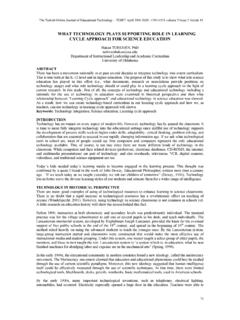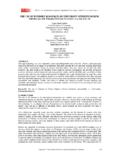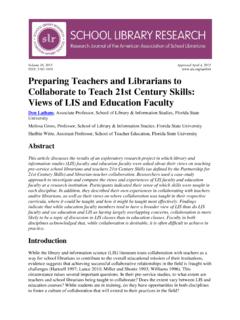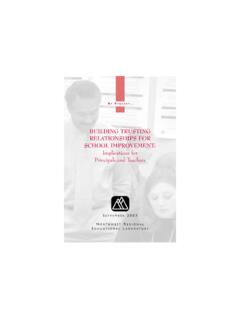Transcription of TEACHERS’ PERCEPTION OF THE ROLE OF MEDIA …
1 The Turkish Online Journal of Educational Technology TOJET January 2009 ISSN: 1303-6521 volume 8 Issue 1 Article 8 75 TEACHERS PERCEPTION OF THE ROLE OF MEDIA IN CLASSROOM TEACHING IN SECONDARY SCHOOLS DR. Sunday TAIWO Principal Lecturer And Head Of Department Of Curriculum And Instruction Federal College Of Education (Special), 1089 Oyo, Nigeria E-MAIL- ABSTRACT This study is an evaluation of teachers PERCEPTION of the role of MEDIA in Oyo State of Nigeria. A total of 150 secondary school teachers of Oyo State participated in the study: 110 trained and 40 untrained teachers randomly selected from ten secondary schools at two gender level (70 females and 80 males). Two MEDIA roles were selected for the study: MEDIA used to supplement the teacher by enhancing his effectiveness in the classroom and MEDIA used to substitute the teacher through instructional MEDIA system. The research tested three hypotheses. The findings revealed that there were significant differences in the perceptions of teachers about each of the two roles of MEDIA identified for the study.
2 In addition there was significant difference found between the perceptions of trained and untrained teachers. However, the teachers gender was not significant. The article discusses the findings and makes some recommendations. Keywords: teacher s PERCEPTION , MEDIA , MEDIA roles , and Technology INTRODUCTION The way teacher view the role of MEDIA in classroom teaching will to a large extent determine the level and degree of its usage. teacher forms an impression which is favourable or otherwise, depending on specific traits teacher attribute to MEDIA . teacher PERCEPTION of MEDIA is predicted upon what they feel MEDIA can do in teaching-learning process. However, evidence abounds that what teachers said were their reasons for not using MEDIA were not true (Zepp, 2005: Scrimshaw, 2004; Sugar, Crawley & Fine, 2004; Cohen, 1996; Hubbord, 1999). Over the years, many research studies have pointed out various external deterrents for the utilization of audiovisual MEDIA .
3 The major deterrents reported were budget difficulty in obtaining materials, lack of audiovisual classroom facilities and lack of trained audiovisual personnel (Higgins & Moseley, 2001; Richardson, 1996; Windschitl & Sahl, 2002). It must be noted that PERCEPTION can be influenced by the personality characteristics of the perceiver. It can also be influenced by the features of the thing/object perceived. Unfortunately, in any PERCEPTION study, one is not sure which has more control over the other (Simonsen & Dick, 1997). Fabos and Young (1999) reported that a 30 minutes sound film entitled Wisconsin makes its law was made available for a minimal rental fee and in sufficient qualities. They later found that it was used by more teachers in Winsconsin elementary schools than any other film. Yet it was not used by the majority of teachers teaching that topic in Winsconsin. Apparently, they concluded that the reasons of cost, unavailability or inappropriateness did not apply.
4 If constraints have lessened, why are MEDIA not used more fully? An answer may well lay within the broad topic of how MEDIA are perceived by the teacher , and how they feature in his thinking and organizational planning (Ross, Hogaboam-Gray & Hanney, 1999). Eichoiz and Rogers (1994) have suggested that here are psychological components in teachers PERCEPTION of MEDIA . Aquino (1994) has found significant personality differences between acceptors and rejectors of new MEDIA . Other researchers have noted that some teachers appeared to perceive MEDIA as threatening and perhaps in human. Lewis (1990) tested fifteen questions in an efforts to determine teacher perceptions relative to education MEDIA . Among his findings were that teachers perceive educational MEDIA as being readily available and that they perceive formal training in the area of audiovisual instruction as being unnecessary. Romiszowski (1998) has grouped the roles of MEDIA into two.
5 In the first instance MEDIA are used as instructional aids, here MEDIA are used exclusively to enhance or enrich the teacher s presentation. MEDIA used in this way are basically one-way transmitters quite incapable of interpreting any messages that the learner may The Turkish Online Journal of Educational Technology TOJET January 2009 ISSN: 1303-6521 volume 8 Issue 1 Article 8 76transmit. Secondly, MEDIA are used as instructional systems. They are used to promote individualization of instruction in both conventional and non-conventional setting. According to Morris (1962) the function of technological MEDIA is to supplement the teacher through enhancing his effectiveness in the classroom. Educational MEDIA are both tools for teaching and avenues for learning, and their function is to serve these two processes by enhancing clarity in communication, diversity in method, and forcefulness in appeal. Except for the teacher , these MEDIA will determine more than anything else the quality of our educational effort.
6 Studies have shown, however, that teachers generally have favourable disposition toward the role of MEDIA , in which MEDIA are used as instructional aids than MEDIA as instructional systems. LITERATURE REVIEW Though funding, equipment, lack of time, and knowledge are known obstacles to successful technology integration (Hardy, 1998; Lam, 2000, Simonsen & Dick, 1997), a critical component in meeting teachers, technology needs is responding to teacher s beliefs toward technologies. Hope (1997) wrote, Teachers basically had to contend with two factors (with technology adoption); (a) the psychological effect of change and (b) learning to use microcomputer technology. (p. 158). Understanding teachers beliefs towards technology play an essentials role in successful technology adoption. Previous studies employed a variety of methods and perspective to assess in-service teachers technology beliefs. These methods included: Likert-scale questionnaires ( , Ross, Hogaboam-Gray & Hannay, 1999) case study methodology ( Ertmer, Gopalakrishnan, & Ross, 2001).
7 German and Sasse (1997) found that teachers who participated in a two-year technology integration program improved their technology self-efficacy and their interest in learning more about how technology could impact the curriculum. Ross, Hogaboam-Gray, and Hannay (1999) reported that access to technologies increased teachers opportunities for successful teaching experiences, thereby contributing to greater confidence in their instructional ability ( ). In addition, they also noted, teachers who interpret their interactions with computers as indicative of high grow in self-confidence, regardless of their experience ( ). Research also reveals that before teachers use technology for instruction they must be personally convinced of its benefits and must see the utility of using a particular technology (Lam, 2000). Before technology is used in the classroom teachers focus attention upon their students. They want to know what impact it will have on students learning outcomes ( , Higgins & Moseley, 2001).
8 Teachers use technology because it motivates students and offers a different mode of presentation. Instead of using computers for drill and practice, more confident teachers use technology as an instructional tool to enhance students learning (Lam, 2000). Successful technology adoption in teachers classrooms is dependent upon school administrators providing an individualized, differentiated process of training and implementation (Gray, 2001) Glean (1997) commented, often districts rely upon a one size fits all approach that meets the needs of only a few participants ( ). Teachers must see how technology fits within their localized classroom setting (Stein, Smith, & Silver, 1999). Teachers technology beliefs are influenced by their philosophy. Resistance to adopting new technologies stem from teachers existing teaching beliefs (Norton, McRobbie, & Cooper, 2000). For technology adoption to be successful teachers must be willing to change their role in the classroom (Hardy, 1998).
9 When technology is used as a tool, the teacher becomes a facilitator and students take a proactive role in learning. Niederhauser and Stoddart (2001) noted a consistent relationship between teachers perspectives about the instructional uses of computers and the types of software they used with their students ( ). Often, this change of teaching philosophy and methods focuses on learners-centered teaching and constructivist teaching practices ( Rakes, Flowers, Casey, & Santana, 1999). In fact, Ertner, Gopalakrishnan, and Ross (2001) found that exemplary technology-using teachers exhibit more constructivist teaching practices. Successful integration of technology into teaching depends on transforming teachers belief and philosophy concurrently (Windschitl & Sahl, 2002). STATEMENT OF THE PROBLEM Specifically the study sought answer to the following questions: 1. How do the secondary school teachers perceive the role of MEDIA identified for the study?
10 2. To what extent do male and female teachers differ in their PERCEPTION of these MEDIA roles ? 3. Are teachers trained in the use of MEDIA more likely to differ from untrained teachers in their perceptions of MEDIA role? The Turkish Online Journal of Educational Technology TOJET January 2009 ISSN: 1303-6521 volume 8 Issue 1 Article 8 77 PURPOSE OF THE STUDY Both the federal and state governments of Nigeria contribute immensely to instructional technology by providing various educational resource centres. In Oyo State alone between 1999 and May 2003, a total of 33 Learning Resource Centres were built with each local government area having at least one. In view of the above, this study seeks to look into how teachers, who are expected to use these MEDIA in their teaching perceive the role of MEDIA . Therefore, the study was designed in the first place to measure and analyse secondary school teachers PERCEPTION of the role of MEDIA .










